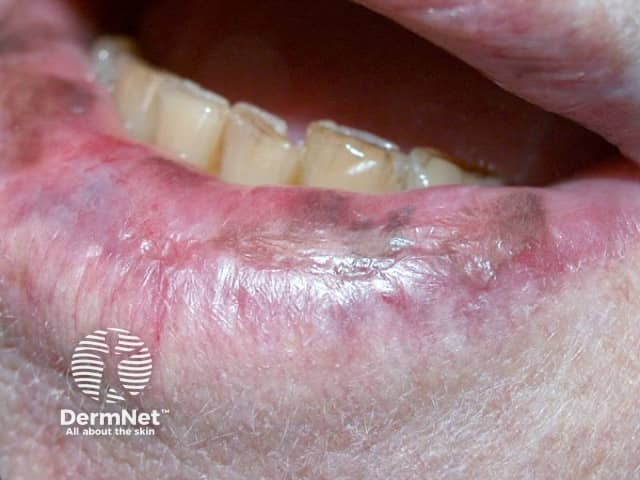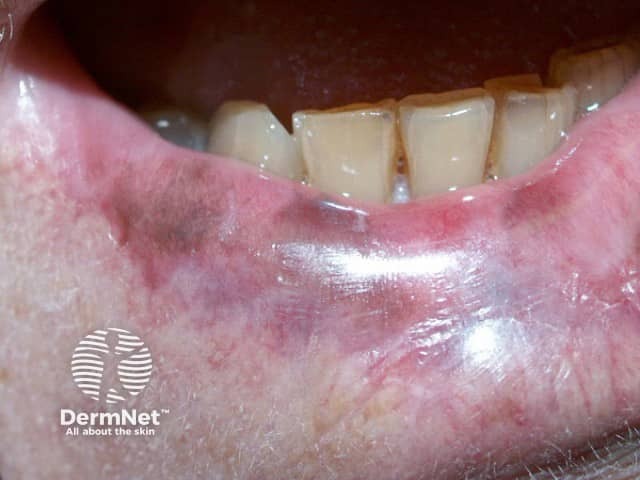Main menu
Common skin conditions

NEWS
Join DermNet PRO
Read more
Quick links
Pigmented contact cheilitis — extra information
Introduction Demographics Clinical features Diagnosis Treatment
What is pigmented contact cheilitis?
Pigmented contact cheilitis is an irritant or allergic reaction to an allergen in contact with the lips that results in brown-black discolouration of the lip(s). Cheilitis is the medical term for inflamed lips.

Lichen planus pigmentosus of lower lip

Pigmented contact cheilitis
Who gets pigmented contact cheilitis and why?
The reported causes of pigmented allergic contact cheilitis include:
- Lipsticks – containing isopalmityl diglyceryl sebacate, ricinoleic acid, dipentaerythritol fatty acid ester, ester gum, 1970s coal tar dyes and other 1-phenylazo-2-naphthol derivatives
- Hair dye – when applied to the moustache, and due to para-phenylene diamine (PPD) found in hair dye
- Green tea – green tea may contain relatively high levels of nickel, a common cause of allergic contact dermatitis
There has also been a case report of pigmented contact cheilitis due to a lipstick that was presumed to be irritant rather than allergic as patch testing was negative.
Given the allergen/irritant sources are common but pigmented contact cheilitis is rare, it is proposed that there is also some, as yet unidentified, predisposing patient factor.
What are the clinical features of pigmented contact chelitis?
The patient may present initially with burning and itchy swelling of the lip(s), suggestive of cold sores. The lip becomes progressively darker, developing a dark purple-black colour, sometimes more obvious after ceasing the product. While still using the product, the lip may be red and scaly in addition to the hyperpigmentation. However pigmented contact cheilitis is generally regarded as a non-eczematous form of cheilitis. The hyperpigmentation may be localised to just the lower lip in the case of the green tea nickel allergy, or to both lips and the vermilion border in the case of a lipstick reaction.
How is pigmented contact cheilitis diagnosed?
Pigmented allergic contact cheilitis is diagnosed on patch testing with a standard allergen series, the patient's own products ‘as is’ and extended series depending on the likely cause. In one report, one of the patient's own lipsticks caused a hyperpigmented positive reaction on patch testing. In another, patch testing was negative but the hyperpigmentation resolved after ceasing use of lipsticks leading to the diagnosis of pigmented irritant contact cheilitis.
What is the treatment for pigmented contact cheilitis?
Avoiding the identified allergen/irritant, usually in lipsticks, results in no further attacks of cheilitis. The pigmentation may fade over 12 months, but may not resolve completely.
References
- Ido T, Nishikawa M, Kiyohara T, Ishiguro K, Kumakiri M. Pigmented contact cheilitis from dipentaerythritol fatty acid ester. Contact Dermatitis 2008: 59: 117–118. PubMed
- Lee JI, Cho BK, Ock SM, Park HJ. Pigmented contact cheilitis: from green tea? Contact Dermatitis 2010: 62: 60–61. PubMed
- Leow Y-H, Tan S-H, Ng S-K. Pigmented contact cheilitis from ricinoleic acid in lipsticks. Contact Dermatitis 2003; 49: 48-49. PubMed
- Mehta V, Nayak S, Balachandran C. Pigmented contact cheilitis to paraphenylenediamine. Indian J Dermatol 2010; 55: 119-120. PubMed Central
On DermNet
- Contact allergic dermatitis
- Cheilitis
- Eczematous Cheilitis
- Contact reactions to lipsticks and other lipcare products
- Lichenoid amalgam reaction
